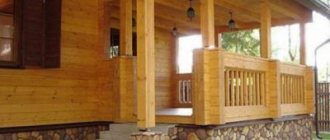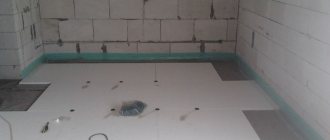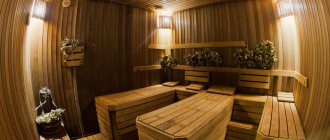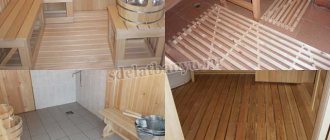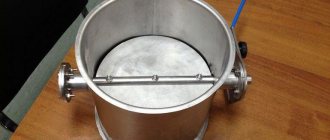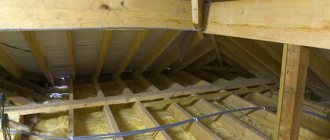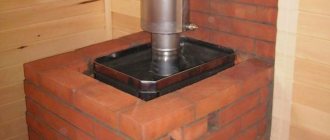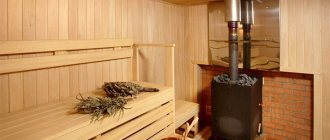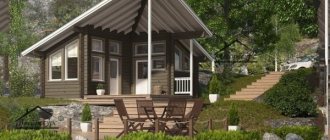A bathhouse is a functional building that combines special sections for health procedures, relaxation and rest. A separate room that requires close attention when arranging is the washing room in the bathhouse.
How a bath sink is designed and what available materials should be used to decorate the interior in order to create optimal conditions for procedures are questions that are of interest to many.
Advantages of the washing compartment
The washing compartment in the bathhouse is arranged in a separate area, fenced off from the steam room, dressing room and relaxation room. In small baths, all rooms are combined, and the washing area is separated from other functional areas by a decorative partition.
The combined option of a washing compartment with a steam room provides significant space savings, but makes the room less convenient to use.
The advantages of a separate sink include:
- the ability to create a unique and practical interior;
- possibility of accommodating a large number of people;
- the possibility of using wear-resistant and durable materials for internal lining;
- simplicity and accessibility of washing machine maintenance.
In a small-sized private bathhouse there can be two rooms: in one there is a dressing room with a relaxation area, in the other there is a steam room with a sink. A stove for a bath and an area for storing bath accessories are located in the steam room, a shower and benches for relaxation are located in the washing bath.
This design has some advantages, including:
- Economical consumption of fuel material for heating combined rooms.
- A laconic and practical interior, when a heater with an extended firebox can be installed in a steam room and washing room. This will provide simultaneous heating of the premises and hot water supply.
Typical design mistakes
To check how correct and controlled the microclimate will be, you need to not only complete construction, but also test the bathhouse at different times of the year. Due to design errors, a typical problem often arises, which is described as follows: “I bought a stove for a three-room sauna, but it can’t handle the heating. There is frost on the walls in the rest room.” The person begins to scold the manufacturer, leaves angry reviews, and demands a refund from the seller.
Of course, this description of the problem lacks details, so the following reasons for its occurrence can be assumed with equal probability:
- Insufficient oven power for three rooms. The heating capacity of the equipment must correspond to the volume of the heated part of the building. A lack of heat may be caused by choosing a low-power model that cannot cope with all tasks at once. In the product passport, the manufacturer always indicates its maximum value. If we are talking about a wood-burning stove for three rooms, then the actual power indicators depend on the species, humidity and other indicators of the quality of the wood.
- High heat loss. Some novice builders believe that a log frame is a ready-made wall. Others make adjustments to the design, based on their own ideas about facades, and make panoramic glazing. The sufficient size of the bath window is 40x40 cm, there is no need to do more. This leads to additional energy losses. One of the conditions for the functioning of a bathhouse is a well-made insulation cake with optimal vapor permeability. This topic must be carefully studied at the design stage, consult with professionals who have experience in the construction of log cabins and frame baths.
- Inappropriate layout. The owner of a private home often has to be tied to the area and configuration of the free territory on the site. In some cases, only a long, narrow building with passage rooms arranged in succession emerges. It is almost impossible to heat three bath compartments with one stove, especially in severe frosts. You have to consume a large amount of firewood to heat the rooms, periodically open the steam room door, and this leads to a drop in the temperature inside. Owners of such problematic bathhouses often solve the heating issue by installing additional electric heaters.
Many steam lovers cannot do without bath procedures in the summer. The most common problem in such cases is the heat in the washing room and dressing room. This is a natural phenomenon, and it can only be minimized by good ventilation. This system should function well at any time of the year, since it serves to regulate the climate during bathing procedures and to remove excess moisture from the premises after their completion.
It is almost impossible to heat three sequentially located bath compartments with one stove, especially in severe frosts - the layout must be thought out in advance.
Requirements for the washing department
Distinctive features of a washing room in a wooden bath are changes in temperature conditions and high humidity, which leads to the creation of comfortable conditions for long-term visitors.
For this reason, such a department must have a reliable ventilation system for good air exchange.
The results of insufficient ventilation are overheating of the body, the appearance of mold and mildew, and the concentration of unpleasant odors and moisture.
The washing room in the bathhouse must meet the basic technical requirements:
- Equipped with forced ventilation of supply or natural type with an air duct pipe. The pipe is equipped with protective flaps to regulate the air flow.
- The air pipe is brought out through a special hole in the ceiling to the roof.
- Installation of the supply pipe 200 cm above the soil level.
- Arrangement of hot and cold water supply systems.
- Carrying out various types of massage using bath cosmetics. For this purpose, a standard massage table or trestle bed is installed in the department.
Hot water options
A shower in a bathhouse needs not only cold, but also hot liquid. The type of equipment depends on the frequency of operation of the steam room and the technical features of communications. Among the popular designs there are 5 models.
Stove heating
Hot water is obtained from a heater designed for use in a bathhouse. Cold moisture entering the heat exchanger heats up and passes into the storage tank under high pressure. When you open the tap, warm liquid flows to the shower faucet.
Stove heating for shower Source texnotoys.ru
During consumption, users must ensure a constant supply of cold water. Comfortable conditions are only available when the stove is running. If there is no electricity in the bathhouse, then a hand pump or motor pump can be used to supply moisture.
Gas
In an area connected to a centralized supply of blue fuel, you can install a column. A flow-type gas heater quickly heats water for a shower in a bathhouse and does not depend on the availability of electricity in the steam room. To install the equipment, follow the operating rules.
Gas shower heater Source master5.kiev.ua
Features of finishing material for washing
The washing room in a wooden bath is practically not subject to heating, but is in contact with water, which eliminates the possibility of using wood for interior decoration. To maintain the overall design of the premises in a bathhouse made of timber, you can use its high-quality imitation.
When choosing materials for the interior decoration of the washing compartment, the following parameters are taken into account:
- resistance to high humidity;
- environmental safety;
- practicality and durability;
- convenient and affordable installation;
- ease of maintenance;
- price.
The most popular finishing materials include wood, tiles, stone, paint, and plastic.
According to their purpose, they are divided into types: for finishing floor, wall and ceiling surfaces. Each of the available options has its own advantages and disadvantages.
What do stove manufacturers offer?
Some manufacturers have developed specialized models of sauna stoves with 3 compartments.
We suggest considering the most advertised design. It consists of the following elements:
- Firebox. The door of the extended fuel channel, which runs through the wall, is located in the dressing room and serves as the main source of heat for it. The powerful cylindrical firebox is designed for heating large rooms. It is installed between the washing room and the steam room.
- Open/closed heater. It is located above the firebox and slightly shifted to the side to be “in the territory” of the steam room.
- Container for water. A conventional rectangular storage tank with a valve for draining water is located in the washing area. The air in the room is heated by the tank.
The obvious disadvantage of this design is that it is installed precisely at the base of the T-shaped connection of the vertical partitions. There is a technological gap of half a brick between the tank and the heater. That is, a massive masonry is needed here, partially supported by the stove itself. Although these partitions do not have a load-bearing function, their own weight is significant.
Another problem is the mass-dimensional characteristics of the furnace itself. It weighs a fair amount even without stones and water, and its width is almost 70 cm. Four people have to carry it into the room, and this requires a fairly wide opening. The installation instructions contain a requirement: installation is allowed only on a concrete base. It will also need to be pre-filled. The stove will occupy a significant part of the area of all three bath rooms.
Wooden panels and lining
Wood is the most sought-after and popular material used for decorative cladding of wall and ceiling surfaces. Finishing a bathhouse sink with wooden panels and lining is the best choice for those who want to get an original interior style.
Due to the high content of resin compounds, the wood is resistant to high humidity, drying out and rotting.
With additional treatment of wood with protective paints, natural oils and wax, the service life of the material is doubled.
- Oil compositions are able to penetrate deeply into the wood structure and reliably protect it from the inside. Before processing, the wooden base is thoroughly cleaned and sanded. The oil is applied evenly in several thin layers. After drying, the surface becomes resistant to the negative effects of moisture.
- Wax is an alternative option for protecting wood, more expensive and durable. It is applied in a circular motion using a piece of soft cloth. Wax is capable of creating a thin film that protects the surface from darkening, drying out and rotting.
- Paints with moisture-repellent properties are used to treat wooden surfaces. They come in matte or glossy. The paint is evenly applied to the surface to be treated with a soft brush in 2-3 layers and left until completely dry.
Finishing a shower room in a bathhouse with clapboards or panels can be made from the following types of wood:
- Larch is a material with high performance characteristics. It is strong, durable and resistant to high humidity. Despite the difficulty in pre-processing, such wood has incredible beauty and aroma.
- Linden is a wear-resistant material that can be used for high-quality sheathing of a sink. It is resistant to darkening, drying out and rotting, and also exudes a pleasant medicinal aroma.
- Cedar, pine and spruce are wood species that are widely used for cladding ceiling and wall surfaces. They are impervious to heat and high humidity, and have a pleasant pine scent.
- Abashi is an exotic wood that is distinguished by its delicate texture and aesthetics, and is resistant to deformation and damage.
Wood finishes can be combined with decorative elements made from natural or artificial stone.
Installation
Multiple Workflows
Having received the model, you need to take care of the base before installation. For 200 kg only concrete will do. Metal, brick on a frame, etc. – it’s best to leave all this for light stoves. Having placed the stove on the base, they immediately check the corners with a building level. Yes, minor deviations are inevitable, but that's okay.
After completing the installation and measurements, be sure to cover the contact plane between the concrete and the furnace itself. And not just cement, but a specialized composition with fire-resistant properties.
Facing masonry does not include a facing type of brick. Only solid, ceramic. When purchasing these materials, it is advisable to consult with the seller, who will definitely convince you of purchasing yellow (fireclay) or red solid ceramic bricks.
The chimney also requires attention. Here it is better to hire an experienced worker. It is worth considering that the manufacturer has already taken care of the diameter of the chimney, so reducing it is prohibited. It is also worth taking care of the health of users and not installing asbestos cement at all.
Ceramic tile
Tiles are wear-resistant, strong and durable materials that have high moisture-resistant properties. It is distinguished by a wide range of colors, texture and size variability. Floors and walls up to 1.7 meters high are tiled.
Before tiling wooden walls, the surface is thoroughly cleaned, a layer of waterproofing is installed and leveled. A moisture-resistant adhesive composition is used to lay the tiles.
In order to properly tile the floor, it is necessary to properly arrange the drainage hole and make a concrete screed. The base is made at a slight angle with respect to the drain hole connected to the sewer pipe.
Tiles have important advantages:
- resistance to high humidity;
- high strength and wear resistance;
- environmental safety and durability;
- resistance to fading and darkening;
- ease of maintenance;
- wide range of colors.
The disadvantages of the finishing material include:
- slippery surface that can lead to injury;
- the difficulty of doing installation yourself (practical skills and knowledge are required);
- susceptibility to mechanical damage.
The ceramic tile finish is successfully combined with natural moisture-resistant paint.
First use
The polymerization process produces a strong odor. Upon completion, the heat-resistant coating will achieve maximum strength and reliability. For the first time, you should heat the stove in a thoroughly ventilated area; do not heat it up too much. You can increase the temperature for subsequent use. It is necessary to conduct a thorough inspection of the structures adjacent to the stove, as well as the chimney. Assess the condition of wood cladding and other products.
The first use will indicate whether the installation of the equipment was carried out correctly.
Artificial and natural stone
Finishing the sink with stone is a practical and durable option. The material is suitable for cladding floors and wall surfaces up to 50 cm in height. An excellent solution for finishing a shower is a combined masonry made of natural and artificial stone.
Natural stone has a number of advantages:
- high environmental friendliness and safety;
- practicality and durability;
- inertness to mechanical damage;
- resistance to high humidity;
- attractiveness and aesthetics.
Among the disadvantages are:
- heavy weight;
- the difficulty of doing independent masonry;
- high cost.
An alternative to expensive natural stone is its artificial counterpart. It is less environmentally friendly, but at the same time lightweight and easy to install.
Varieties
Depending on the material used, sauna stoves are made of metal or baked brick.
Brick
A brick (or stone) stove is a classic of bathhouse buildings, but its construction requires certain experience and skills, compliance with safety regulations, knowledge of the technology for ensuring good traction and other important nuances, without which the proper functioning of the stoves is impossible. In addition, a stone structure requires sufficient space in the room, the creation of a separate foundation, and special compliance with fire safety rules.
Metal
Today, the most economical option is metal sauna stoves, which have a number of undeniable advantages.
- Economical. The metal stove is compact, its installation does not take much time and space.
- Huge selection of options. It is possible to choose a model suitable for a specific bath.
- Ease of installation. In order to install a ready-made metal stove, no stove making skills are required.
- Due to its compactness, a metal stove can be covered with a heater. This way it will keep warm for a long time and look like a classic sauna stove.
Plastic panels
Finishing a washing room in a wooden bath using PVC panels is an affordable and cheap option. This material is characterized by high moisture resistance, practicality and ease of installation. It is used for cladding ceiling and wall surfaces. Thanks to the wide range of models and variety of colors, you can choose the most suitable option for cladding wall and ceiling surfaces.
The walls and ceiling in the washroom, lined with plastic panels or lining, can look quite presentable.
The advantages of the material include:
- affordable price;
- practicality;
- resistance to high humidity;
- easy installation on a wooden grid or adhesive base;
- attractive appearance.
PVC cashing has some disadvantages:
- susceptibility to mechanical stress;
- tendency to darken and burn out;
- short service life;
- low environmental friendliness.
Important! Plastic panels are installed after installing waterproofing on wall and ceiling surfaces. All work is carried out only after the finished bath has shrunk, in order to prevent distortion and violation of the tightness of the lining.
Exploitation
Kindling is done with dried firewood. For this it is better to use deciduous trees. It is undesirable to use coniferous raw materials, since the resin fumes from coniferous wood will quickly clog the chimney.
When raking out the ash, it is necessary to leave at least a few millimeters - this will serve as a thermal layer between the concrete base and the burning wood.
The diameter of the chimney is quite large, so if used properly, cleaning will be required no more than once every three years.
The cleaning hatch is located at the rear of the oven. If you plan to completely cover the stove with bricks, you must plan access to the cleaning hatch in advance.
When lighting, the tank must be filled with water. After using the sauna during the winter months, the remaining water in the tank must be completely drained, since at low temperatures the solidifying water can tear the metal.
Nuances of operation
After the first warm-up, you can increase the temperature, but before that, inspect the entire structure: the chimney, the stove itself and everything that is adjacent to it. Assess whether the wooden elements are damaged. If after the first warm-up there are no comments, the installation was carried out correctly. Subsequent operation is carried out in compliance with some nuances.
- Choose only dry firewood, ideally hardwood. Coniferous firewood emit resin fumes, which means that the chimney will become clogged with soot in a much shorter period of time. The fastest wood to clog a chimney is maple, spruce and pine.
- When removing ash, do not remove it completely; leave a thin layer so that a thermal layer is formed between the burning fuel and the concrete. There should also be some soot left on the walls to improve the combustion process.
- Since the diameter of the chimney of the Gorynych models is quite wide, frequent cleaning will not be required if the operating rules are followed. The minimum frequency of chimney cleaning is once every 3 years.
- Do not block access to the cleaning hatch.
- The stove operates according to the standard, but it is necessary to carry out the first 2 fires with the windows and door open.
- If you decide to use old wood for kindling, make sure that there are no dyes or adhesives on it.
- The tank is filled with water after the fire starts.
- If the bathhouse does not warm up in cold weather and cools down to sub-zero temperatures, pour the water out of the tank, otherwise the seams may burst.
Reviews
On the World Wide Web you can find many opinions about this product. The majority of buyers who purchased the Gorynych 3 stove were satisfied with their purchases. The furnace fulfilled all its obligations. I can't help but be pleased with the favorable price. Some users noted that buying a ready-made stove from a Russian manufacturer is much more profitable than ordering an individual assembly.
There are also negative reviews, although they are associated with the above-mentioned disadvantages of the model: heavy weight and size. Before purchasing, you must take into account the required minimum dimensions of the bath.
- Sources used in the article:
https://banyaskazka.ru/pechi-i-dymohody/pech-gorynych-3-chertezh - https://minecrew.ru/uteplenie/pech-bannaja-gorynych-3-shema-chertezhi.html
- https://ZnatokTepla.ru/pechi/gorynych.html
- https://krovli-zabori.ru/steny/pech-gorynych-3-chertezh.html
- https://OasisTepla.ru/stroim-banyu/pech-na-tri-pomeshcheniya-v-bane-2.html
- https://stroy-podskazka.ru/banya/pechi/gorynych-3/
- https://o-vannoy.ru/pechi/gorynych/
Rubble concrete foundation
Foundation for the stove.
The formwork must be installed on the base. A layer of large stones is placed in it. The resulting cavities are filled with crushed stone. Then the stone and crushed stone are filled with cement-sand mortar.
Mix the solution as follows: 1 part cement M 400-500 to 3 parts sand. The solution should be thick, like sour cream. They need to pour the first row of stone and take a break for a day, then lay the next row, which is then poured with mortar.
If the volume is small, then you can make a certain amount of concrete and complete the work in one day. After about a week, the foundation is ready for laying.
Recommendations
When equipping a steam room, you need to take into account the features of this space.
The main point is the complete drainage equipment. Any steam room must have a high-quality drain through which water flows. It must be equipped in such a way that water flows towards the main pipe. It is through it that the water leaves the steam room. Despite the fact that many people think this system is more suitable for showers or washrooms, it can also be safely used in steam rooms. Having planned a full-fledged sewer system, it is worth working on this process from the very beginning. To do this, you need to lay the pipe at the stage when the foundation is being created. Ideally, it should be taken out into a pit located at least three meters from the bathhouse. Often this very pit is additionally lined with bricks or dense concrete rings. The bottom in this case is laid out with gravel. All this guarantees reliable protection against waste leakage.
Another equally important point is thermal insulation. A good steam room must be well insulated, and there are many ways to make this idea a reality. This includes a high-quality foil coating, which, due to its thinness, prevents the construction of too dense a finish, as well as mineral wool and other materials.
When choosing one type of insulation, you should definitely take into account that most of them react negatively to high levels of humidity. If this is the case, then it is necessary to additionally waterproof the protective layer.
It is also important to take into account the presence of adequate and high-quality ventilation. This is a very important detail
If the ventilation is poor, then it is unlikely that you will be able to fully relax in the steam room. Instead of relaxation and rest, headaches and problems with the cardiovascular system may occur.
Hoods, according to professionals, should be located at the top. The fact is that when the air heats up, the temperature first rises at the top. Therefore, it is in this area that ventilation holes and supply vents are located. They must also be supplemented with special exhaust grilles. It is these structures that are responsible for allowing cool air into the room.
In some cases, steam room owners prefer to make do by periodically opening the doors or windows during procedures. It’s easy to guess that this is not enough, and you can’t do without a full-fledged ventilation system. Its installation must be taken responsibly, and, if possible, the structure should be located closer to the stove so that the cold air coming from the street is immediately warmed up, because cold air is contraindicated in such conditions.
In conclusion, we can say that if a person can make a steam room correctly, that is, equip and insulate it, then he will be able to get maximum pleasure. And this will give you the opportunity to enjoy not only the work done, but also the visit to the steam room. The main thing is to avoid even minor mistakes.
To learn how to properly decorate a steam room in a bathhouse, see the following video.
Ventilation in the steam room of the bath: diagram
Ventilation in the steam room of a bathhouse - system diagram. It consists of two openings: one of which is supply, and the other is exhaust (several exits can be made). When choosing the size of the exhaust opening, you must follow several rules:
- the largest should be at the maximum distance from the stove (so that the heat does not flow outward);
- the rest can be placed around the perimeter of the ceiling;
- The hole size is calculated based on 24 square meters. cm for each cubic meter of room. Most often, the diameter does not exceed 30 cm, but the number is 2 or more.
The traction force is determined by the height difference between the supply and exhaust openings.
IMPORTANT! Do not place the holes exactly opposite each other, this will inevitably cause drafts.
We recommend using dampers or plugs for manual adjustment.
Ventilation in a Russian steam bath: diagram
Ventilation in the Russian steam bath is ensured by a scheme in which there are vents with adjustable plugs, taking into account the above rules. Or by using burst ventilation, which we will discuss later.
Bathhouse: steam room ventilation (if the stove is in the dressing room or rest room)
For a bathhouse or steam room ventilation, where the stove is located in a room other than the steam room, you will most likely have to think about forced ventilation, which will ensure the flow moves in the right direction.
As shown in the diagram:
Bathhouse: ventilation of the steam room (if the stove is in the steam room or the steam room is connected to the washing room)
It is ensured by heating cold air coming from outside from the furnace and repelling it from the heat source, and returning it back after hitting the walls. Air movement can be stimulated by the use of additional fans.
For bathhouses and steam room ventilation, organizing the drying of the bathhouse is especially important, since water in the washing room can have a truly destructive effect on finishing materials and the floor. In addition to the main one, enhanced floor ventilation is required: by installing an exhaust opening between the finished and subfloor, the installation can be accompanied by the installation of a fan.
REFERENCE. Make sure that no water comes into contact with the fan to avoid the risk of a short circuit.
Other selection criteria
Volume of the tank
In order not to make a mistake with the size of the tank, it is enough to make a simple calculation. On average, one person needs a bucket of water for washing, that is, 8-10 liters. Knowing how many people will visit the bathhouse regularly, you just need to multiply this number by 10 and add another 20-25 liters in reserve.
| Photo | Volume | Dimensions | Material and thickness | Approximate price |
| Tank on the wall | 60 l | 500x505x250 mm | stainless steel, 1 mm | RUB 3,990 |
| Tank on the wall | 31 l | 500x365x170 mm | stainless steel, 1 mm | RUB 3,290 |
| Tank on the stove | 80 l | 450x600x300 mm | stainless steel, 1 mm | RUB 9,690 |
| Tank on the wall | 90 l | — | stainless steel | RUB 4,410 |
| Tank on a pipe (for Dobrostal stoves) | 52 l | 385x385x830 | stainless steel, 1.5 mm | 6,900 rub. |
Installation method
Several factors are important here: the performance of the stove, the area of the steam room, the volume of the container. If the room is spacious and the stove is small, it is not advisable to reduce its performance with a built-in tank of 60 liters or more. In this case, the tank must be made remote or mounted on a pipe. If the steam room is small and the efficiency of the stove is high, the water in the small tank will quickly boil away. That is why it is necessary to carefully analyze all the conditions and select the optimal solution.
Convenience in the bathhouse also means a lot. The tank should be located so that the risk of getting burned on a hot surface is minimal, and water intake is convenient. If the container is located high (remote or samovar type), a tap is needed to supply hot water. Drawing water through the top is very inconvenient and unsafe.
If you carefully study the conditions, think through and weigh everything, choosing a hot water tank will not be difficult. With a well-chosen design, bath procedures will bring you only comfort and pleasure for many years.
Approximate cost of stainless steel and enameled tanks
| Tank type | Height | Volume | Wall thickness, mm | Cost, rub. |
| Samovar-type enameled tank | 550 mm | 50 l | 1,5 | 5620 |
| Samovar-type enameled tank | 600 mm | 63 l | 2 | 6099 |
| Stainless steel external vertical tank | 580 mm | 60 l | 1 | 4500 |
| Horizontal stainless steel tank | 470 mm | 60 l | 1,5 | 4500 |
| Samovar-type stainless steel tank | 500 mm | 43 l | 0,8 | 3500 |
| Samovar-type stainless steel tank | 700 mm | 60 l | 1,5 | 6080 |
